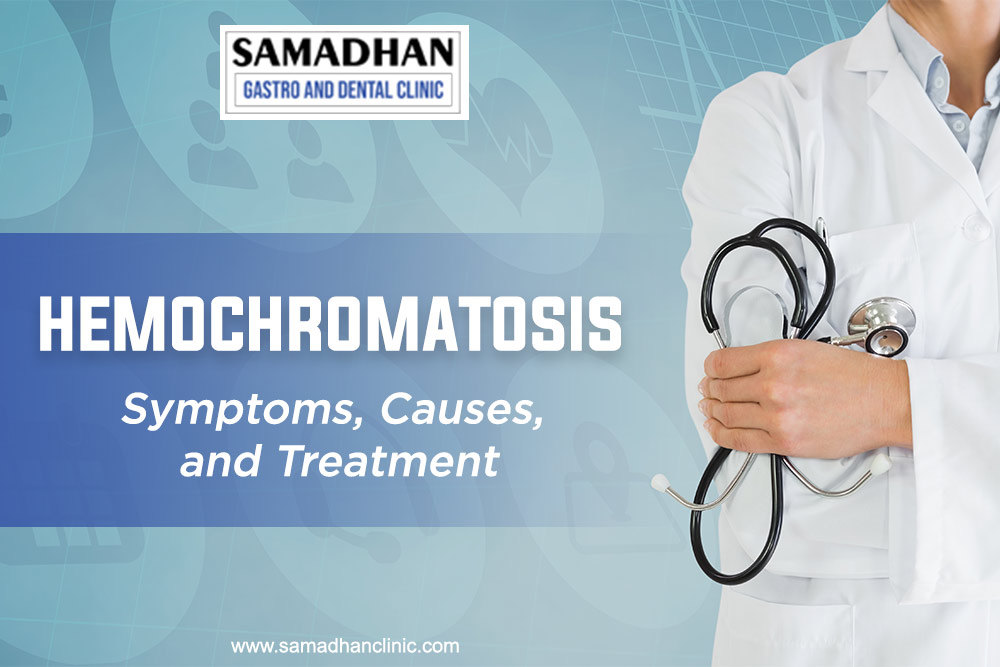
Hemochromatosis: Symptoms, Causes, and Treatment
Hemochromatosis is the condition in which extra iron accumulates in the body. This disorder is sometimes also known as iron overload as the amount of iron in the body increases too much higher levels than the normal amount. It can be a very dangerous condition for the body if not treated timely.
Normally, our body absorbs only the required amount of iron from the intestines. But certain hereditary conditions can cause more iron absorption that can lead to hemochromatosis in the body. Other than that many external reasons can also lead to increased iron. This increased iron can get deposited in various organs of the body like the liver, joints, etc, and cause various problems to the patients.
In this article, we will discuss hemochromatosis in detail. All its symptoms, causes, and treatment options will be discussed here.
Hemochromatosis Symptoms
Most people that suffer from hereditary hemochromatosis do not suffer from hemochromatosis symptoms until the age of 30. It is more commonly seen in men as the woman loses iron during the menstrual cycle. But the women are also prone to hemochromatosis symptoms after menopause when the menstrual bleeding stops completely.
Some people might not suffer from any symptoms and this condition is only diagnosed by a blood test.
The hemochromatosis symptoms can be differentiated into early and late manifestations.
Symptoms that are seen in the early stages of the disease include:
- Fatigue
- Weakness
- Weight loss
- Erectile dysfunction
- Joint pain
- Irregular periods (decreased frequency or absent periods)
- Changed color of the skin (grayish or bronze)
- Loss of body hair
All these hemochromatosis symptoms are vague and do not point towards hemochromatosis specifically. These symptoms can also occur in various other conditions or can be just age-related. So, it is hard to diagnose hemochromatosis at this early stage based on these symptoms.
Symptoms that are commonly seen in the later stages of this disease include the following:
- Loss of sex drive or libido
- Abdominal pain and swelling
- Jaundice (yellowish discoloration of eyes and skin)
- Severe pain and swelling in the joints, specifically that of your knuckles
- Arrhythmia (irregular heartbeat)
- Chest pain
- Shortness of breath
- Edema in the body
- Feeling of constant thirst
- Increased frequency of urination
All these hemochromatosis symptoms of the later stages occur when the increased iron levels start affecting various organs of the body like the liver, heart, lungs, etc.
Hemochromatosis Causes
Hemochromatosis can be of 2 types:
Primary hemochromatosis
Secondary hemochromatosis
Primary hemochromatosis
This is hereditary which means that it runs in families. Both the mother and the father pass down one copy of the same gene to their child. Hemochromatosis is a recessive disease which means that the baby will only suffer from hemochromatosis if he gets the faulty gene from both his parents.
In case only one of the parents has the gene for hemochromatosis, which is then passed down to their child, the child will have only one faulty gene and will not show the symptoms of the disease. But he will be a carrier of the disease. This means that he can pass down this gene to his babies in the future.
Patients suffering from primary hemochromatosis start developing symptoms at around 30 years of age.
Secondary hemochromatosis
Secondary hemochromatosis is a condition that is caused by some secondary causes. The factors that can cause Secondary hemochromatosis to include:
- Anemia
- Liver disease
- Frequent blood transfusions
The iron is mainly removed by the liver. Some liver diseases can hinder this iron removal from the body and cause an overload of iron in the body leading to Secondary hemochromatosis.
The blood that is transfused in patients is similar to the blood in our body in respect to its contents. This blood also contains the amounts of iron normally present in the blood. People who require frequent blood transfusions, accumulate this extra iron in their bodies and this leads to Secondary hemochromatosis.
Certain types of anemia can require frequent blood transfusions and cause iron overload in the body.
Hemochromatosis Treatment
The diagnosis of hemochromatosis can be a little difficult because all the symptoms of the disease are very vague and can be due to a lot of other conditions. Your doctor will take a detailed medical history that will include a detailed history of your symptoms, any previous medical conditions like anemia, liver disease, history of blood transfusions, family history, etc.
If you have any significant past history or family history for hemochromatosis, then it is easier to come to the final diagnosis. This medical history will be followed by a physical examination.
Your doctor will also suggest some blood tests like an iron profile for you to check your iron levels.
After the final diagnosis of hemochromatosis, your hemochromatosis treatment will be started. There is no definite cure for the disease but there are some hemochromatosis treatment options that will help alleviate your symptoms. These include:
- Phlebotomy
- Chelation therapy
Phlebotomy
The excess iron from your body can be removed by removing some of your blood. This process works exactly like donating blood. A small needle will be inserted into your vein and some amount of blood will be taken out. The excess iron will be removed with the removal of the blood. This hemochromatosis treatment option might have to be done for your entire life if you are suffering from primary hemochromatosis.
Chelation therapy
Frequent phlebotomy may not always be possible for people because of a variety of reasons like small, thin veins, etc. Chelation therapy can be used in such cases. During this process, a medicine is given to you that binds with the iron present in your blood and helps remove it in your urine or stools. This hemochromatosis treatment option helps remove the excess iron from your body.
The medicine used for this purpose is deferoxamine.
For people suffering from secondary hemochromatosis, treating the underlying issue is the definite hemochromatosis treatment. If a person needs to get frequent blood transfusions, then the above-mentioned chelation therapy can be used in conjunction with the transfusions to prevent iron overload.
You should choose a good liver specialist doctor in Delhi for your hemochromatosis treatment as the timely diagnosis and treatment of hemochromatosis is very essential. Dr. Shri Ram Agarwal, at Samadhan clinic, is the best liver specialist doctor in Delhi who can help you with your symptoms and provide good hemochromatosis treatment to you.

